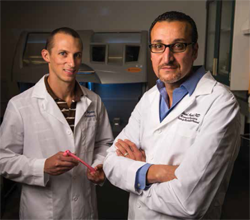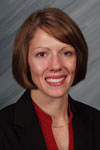
Jason Inzana and Dr. Hani Awad
A recent article in Hajim School of Engineering' and Applied Sciences' newsletter, The Full Spectrum, features examples of how tissue engineering research at the Biomedical Engineering Department, much of which is conducted in preclinical models to heal traumatic injuries, is bolstered by the work of BME faculty and graduate students in the laboratories of professors Awad, Benoit, and Buckley, capitalizing on close ties with the Center for Musculoskeletal Research.
As part of a consortium of research projects funded by AOTrauma, Dr. Hani Awad and his lab members are using new 3D printing technology to fabricate bone scaffolds made of biocompatible material to replace the original bone tissue lost to infection. As part of the printing
process, the scaffolds can be ink-jetted
with antibiotics to fight the infection and with growth factors to stimulate replacement bone growth. These therapeutics can be applied to the surface of the graft, or embedded uniformly in it, so they can be released gradually, as the graft dissolves, to ensure the infection is eradicated and to stimulate regeneration of the bone tissue.

Dr. Danielle Benoit

Dr. Mark Buckley
With support from a National Institutes of Health grant, Dr. Danielle Benoit's team is exploring the use of hydrogels - Jell-O-like polymers - that can be seeded with the patient's own stem cells and wrapped around the transplant. Benoit's graduate student Michael Hoffman has demonstrated that as the hydrogel dissolves, the stem cells are gradually released and promote bone healing and integration. Benoit is exploring various ways in which this can all be orchestrated to maximize graft healing and integration.
Dr. Mark Buckley, who joined biomedical engineering as an assistant professor at the start of the year, is studying heat buildup in tendons as they are stretched during various activities and the extent to which this contributes to cell death and eventual deterioration of the tendon. A key part of this research involves characterizing exactly what constitutes healthy tendon structure and function.